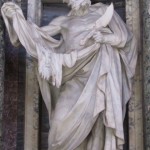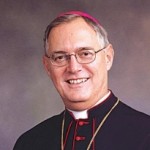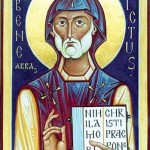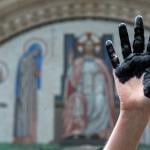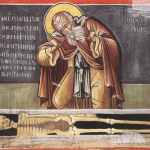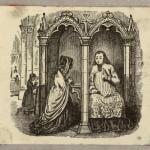Our friend Fr. Steve, who is a Salesian priest informs us that the relics of Don Bosco, founder of the Salesian Order will be making a world tour!
In the tradition of pilgrimage, the relics of St. John Bosco are being carried into the towns and villages, neighborhoods and centers where the Gospel is announced among the young and the poor today. This pilgrim journey through 130 nations began on January 31, 2009, the 150th Anniversary of the founding of the Salesian Congregation. It prepares us for the 2010 celebration of the 200th Anniversary of Don Bosco’s birth near Turin, Italy on August 16, 1815. For more information on the tour please click the Don Bosco Among Us site.

Deacon Greg gives details:
“. . . the bones and tissues of the right hand and arm of the 19th-century Italian saint have been placed within a wax replica of St. John Bosco’s body, which is being displayed in a glass box mounted on a large wood and metal cart.
The display — weighing more than 1,800 pounds and measuring approximately 8 feet long, 3 feet wide and 4 feet tall — has been transported around the world by plane and in specially designed and built trucks.”
But is it biblical? Is this just another weird Catholic tradition? Yes. No. Remember the hemorrhagic woman who touched only the tassel of Jesus’ cloak. Also:
From the very beginning, some Christians believed that miracles could be linked to these bits of bones, strands of hair or items of clothing, notes Robert Garrity, aCatholic chaplain and adjunct professor of theology at Ave Maria University in Florida.
“Take a look at Acts of the Apos-tles 19:12 where a handkerchief touching St. Paul was said to provide healing for people who were sick,” Garrity says. “And there are other passages as well” – including some in the Old Testament.
In 2 Kings 13, for example, a dead man returns to life after his corpse came in contact with the bones of the prophet Elisha. After the rise of Christianity, sick people sought similar miracles, drawing near to relics and praying for divine healing.
So, a handkerchief that had touched St. Paul’s person would be what we call a “second class relic” – something that a saint or holy person had possessed, worn, used. I am fortunate to posses a second-class relic of St. Philip Neri that happened to come my way just as he became my patron for 2010; it is a small bit of fabric from one of his robes:

Not a great photo, sorry. The relic remains on my oratory, reminding me each day of what St. Philip has to teach me, if I only ask for his companionship, prayers and tutelage.
Also, those in the New York area who have a devotion to the seer and Visitation nun St. Margaret Mary Alacoque will be able to visit her first-class relics within the Diocese of Rockville Centre:
St. Margaret Mary, a 17th century French mystic, promoted the devotion to the heart of Jesus and called for Catholics to receive the Eucharist on the first Friday of every month as reparation for sins.
Check the links for schedules.
UPDATE: And consider John the Baptist
Related:
The Crying Out of Flesh and God


